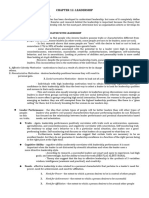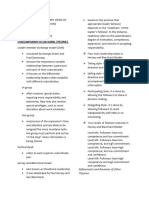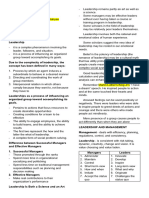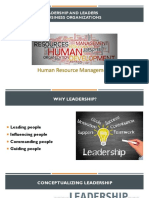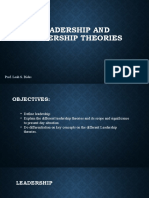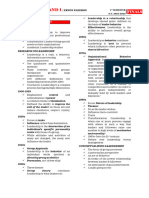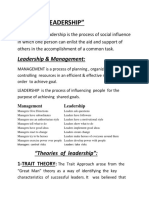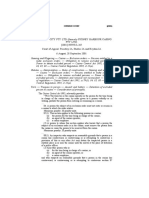0 ratings0% found this document useful (0 votes)
52 viewsChapter 12
Chapter 12
Uploaded by
Kryz MaLyne Pataray FerrerThe document discusses several theories of leadership, including:
1) Fiedler's contingency model which holds that a leader's effectiveness depends on how well their style fits the situation.
2) Path-goal theory which proposes four leadership styles - instrumental, supportive, participative, and achievement-oriented - that can be adopted based on the situation.
3) Leader-Member Exchange (LMX) theory which states that leaders develop different relationships with different subordinates and act differently with each.
4) GLOBE study findings that cultural dimensions like uncertainty avoidance and power distance impact leadership expectations across cultures.
Copyright:
© All Rights Reserved
Available Formats
Download as DOCX, PDF, TXT or read online from Scribd
Chapter 12
Chapter 12
Uploaded by
Kryz MaLyne Pataray Ferrer0 ratings0% found this document useful (0 votes)
52 views3 pagesThe document discusses several theories of leadership, including:
1) Fiedler's contingency model which holds that a leader's effectiveness depends on how well their style fits the situation.
2) Path-goal theory which proposes four leadership styles - instrumental, supportive, participative, and achievement-oriented - that can be adopted based on the situation.
3) Leader-Member Exchange (LMX) theory which states that leaders develop different relationships with different subordinates and act differently with each.
4) GLOBE study findings that cultural dimensions like uncertainty avoidance and power distance impact leadership expectations across cultures.
Original Description:
INDUSTRIAL ORGANIZATIONAL PSYCHOLOGY
Copyright
© © All Rights Reserved
Available Formats
DOCX, PDF, TXT or read online from Scribd
Share this document
Did you find this document useful?
Is this content inappropriate?
The document discusses several theories of leadership, including:
1) Fiedler's contingency model which holds that a leader's effectiveness depends on how well their style fits the situation.
2) Path-goal theory which proposes four leadership styles - instrumental, supportive, participative, and achievement-oriented - that can be adopted based on the situation.
3) Leader-Member Exchange (LMX) theory which states that leaders develop different relationships with different subordinates and act differently with each.
4) GLOBE study findings that cultural dimensions like uncertainty avoidance and power distance impact leadership expectations across cultures.
Copyright:
© All Rights Reserved
Available Formats
Download as DOCX, PDF, TXT or read online from Scribd
Download as docx, pdf, or txt
0 ratings0% found this document useful (0 votes)
52 views3 pagesChapter 12
Chapter 12
Uploaded by
Kryz MaLyne Pataray FerrerThe document discusses several theories of leadership, including:
1) Fiedler's contingency model which holds that a leader's effectiveness depends on how well their style fits the situation.
2) Path-goal theory which proposes four leadership styles - instrumental, supportive, participative, and achievement-oriented - that can be adopted based on the situation.
3) Leader-Member Exchange (LMX) theory which states that leaders develop different relationships with different subordinates and act differently with each.
4) GLOBE study findings that cultural dimensions like uncertainty avoidance and power distance impact leadership expectations across cultures.
Copyright:
© All Rights Reserved
Available Formats
Download as DOCX, PDF, TXT or read online from Scribd
Download as docx, pdf, or txt
You are on page 1of 3
Chapter12 Task-oriented leaders - see their employees as
lazy, extrinsically motivated, wanting security,
Leadership
undisciplined, and shirking responsibility
Leader emergence - the idea that people who
(team)- are both task and person oriented,
become leaders possess traits or characteristics
different from people who do not become whereas the worst (impoverished) -are neither
leaders. task nor person oriented.
affective identity motivation- People become Some leaders (middle-of-the-road)- have
leaders because they enjoy being in charge and moderate amounts of both orientations.
leading others.
Leadership Opinion Questionnaire (LOQ) -filled
Non-calculative motivation seeks leadership out by supervisors or leaders who want to know
positions when they perceive that such positions their own behavioral style
will result in personal gain.
Leader Behavior Description Questionnaire
social-normative motivation-people become (LBDQ)- completed by subordinates to provide a
leaders out of a sense of duty. For example, a picture of how they perceive their leader’s
member of the Kiwanis Club might agree to be behavior.
the next president because it is “his turn,” or a
Narcissists- are leaders who overcome their
faculty member might agree to chair a
insecurity by overconfidence.
committee out of a sense of commitment to the
university. Fred Fiedler in the mid- 1960 developed The
best-known and most controversial situational
leader performance- involves the idea that
theory.
leaders who perform well possess certain
characteristics that poorly performing leaders do Fiedler’s contingency model -holds that any
not. individual’s leadership style is effective only in
certain situations.
self-monitoring - is especially interesting, as it
focuses on what leaders do as opposed to what Least-Preferred Coworker (LPC) Scale-To help
they are. people understand their leadership style,
leaders identify the subordinate or employee
leadership motive pattern- demonstrates the
with whom they would least want to work.
high-performance managers.
task structuredness -Structured tasks have goals
Job Choice Exercise (JCE)- developed by Stahl
that are clearly stated and known by group
and Harrell 1982. the person reads descriptions
members, have only a few correct solutions to a
of jobs that involve varying degrees of power,
problem, and can be completed in only a few
achievement, and affiliation needs and rates
ways
how desirable he finds each job.
leader position power- the greater the position
Managerial Grid - (Blake & Mouton, 1960 have
or legitimate power of the leader, the more
postulated that differences in leader
favorable the situation.
performance can be attributed to differences in
the extent to which leaders are task versus leader–member relations- The more the
person oriented. subordinates like their leader, the more
favorable the situation.
Leader Match- probably the only training achievement-oriented style - sets challenging
program in the country concentrating on goals and rewards increases in performance.
changing the situation rather than the leader. Achievement oriented style- sets challenging
goals and rewards increases in performance.
IMPACT theory- was developed by Geier,
Downey, and Johnson (1980), who believed that situational leadership theory- theory that
each leader has one of six behavioral styles: focuses on the relationship between leader and
informational, magnetic, position, affiliation, follower
coercive, or tactical.
Leader–member exchange (LMX) theory - was
informational style- provides information in a developed by Dansereau, Graen, and Haga
climate of ignorance, where important (1975) and was originally called vertical dyad
information is missing from the group linkage (VDL) theory. LMX theory is a unique
situational theory that makes good intuitive
magnetic style- leads through energy and
sense.
optimism and is effective only in a climate of
despair, which is characterized by low morale. LMX theory-states that leaders develop
different roles and relationships with the people
position style- leads by virtue of the power
under them and thus act differently with
inherent in that position, individuals who use a
different subordinates
position style will be effective only in climates of
instability. Uncertainty avoidance: The extent to which a
culture avoids uncertainty by using social norms
affiliation style- leads by liking and caring about
and rituals
others
Power distance: The extent to which power is
coercive style leads by controlling reward and
unequally shared
punishment and is most effective in a climate of
crisis Social collectivism: The extent to which a
culture encourages collective distribution of
tactical style- leads using strategy and is most
resources
effective in a climate of disorganization.
In-group collectivism: The extent to which
path–goal theory- a leader can adopt one of four
individuals express pride in their organizations
behavioral leadership styles -to handle each
and families
situation: instrumental, supportive,
participative, or achievement-oriented. Gender egalitarianism: The extent to which a
culture tries to minimize differences in gender
The instrumental style -calls for planning,
roles and prevent discrimination
organizing, and controlling the activities of
employees. Assertiveness: The extent to which individuals
in a culture are assertive and challenging in social
The supportive-style- leader shows concern for
relationships
employees,
Future orientation: The extent to which a
the participative style- leader shares
culture plans for and invests in the future
information with employees and lets them
participate in decision making,
Performance orientation: The extent to which a
culture encourages and rewards improvement in
performance
Humane orientation: The extent to which a
culture encourages and rewards people for
being fair, caring, and giving
charismatic style- involves vision, inspiration,
integrity, and a performance orientation. self-
protective style -involves following procedure,
emphasizing status differences, being self-
centered, and saving face.
humane style -involves being modest and
helping others.
team-oriented style -involves being
collaborative, building teams, and being
diplomatic.
participative style -involves getting the opinions
and help of others. An autonomous style
involves being independent and individualistic
and making one’s own decisions
You might also like
- Chapter 8 LeadershipDocument28 pagesChapter 8 LeadershipEloisa Karen MonatoNo ratings yet
- Caldoor Price ListDocument29 pagesCaldoor Price ListDean ParrNo ratings yet
- 051424chap12 IOReviewerDocument6 pages051424chap12 IOReviewer2021-110411No ratings yet
- Leadership: Wisnumurti RahardjoDocument49 pagesLeadership: Wisnumurti RahardjoRaminson SiregarNo ratings yet
- LeadershipDocument63 pagesLeadershipwaleNo ratings yet
- Bahr FinalsDocument5 pagesBahr FinalsNikki KatesNo ratings yet
- Chapter 12Document9 pagesChapter 12Joshua MalloNo ratings yet
- Leadership in EducationDocument28 pagesLeadership in Educationnnita7776No ratings yet
- LM Midterm PPT CompilationDocument447 pagesLM Midterm PPT CompilationRyann DizonNo ratings yet
- HBO Output Chapter 13Document3 pagesHBO Output Chapter 13mary ann rosendoNo ratings yet
- Leadership ReviewerDocument24 pagesLeadership ReviewerMavery KimNo ratings yet
- Leadership 2Document16 pagesLeadership 2amity_acelNo ratings yet
- Chapter 17Document10 pagesChapter 17wulan.permatasariNo ratings yet
- Leadership and LeadersDocument21 pagesLeadership and LeadersMarina TsarovaNo ratings yet
- Session 3 Traditional and Contingency Leadership ApproachesDocument26 pagesSession 3 Traditional and Contingency Leadership ApproachesCsec helper1No ratings yet
- Chapter 8Document47 pagesChapter 8Jaya Raj JoshiNo ratings yet
- An Anlysis of Leadership Styles in Indian Organizations (2017)Document10 pagesAn Anlysis of Leadership Styles in Indian Organizations (2017)VijayNo ratings yet
- LeadershipDocument3 pagesLeadershipLaNcEL0t GamingNo ratings yet
- Chapter 7 LeadershipDocument28 pagesChapter 7 LeadershipLYRRAHNo ratings yet
- Leadership: Prof. Jayashree SadriDocument60 pagesLeadership: Prof. Jayashree SadriSachin SinghNo ratings yet
- Week 6 Workshop LeadershipDocument50 pagesWeek 6 Workshop LeadershipvaseemmanafNo ratings yet
- Concept in Leadership Leadership Is : GrowthDocument19 pagesConcept in Leadership Leadership Is : GrowthNelsonMoseMNo ratings yet
- LeadingDocument6 pagesLeadingdummyNo ratings yet
- Presentationonleadership 110924023828 Phpapp01Document33 pagesPresentationonleadership 110924023828 Phpapp01Daniel RandolphNo ratings yet
- TQM Chapter 17Document3 pagesTQM Chapter 17jannahkamylgNo ratings yet
- Leadership and Management - 4th Years KuDocument68 pagesLeadership and Management - 4th Years KuKentoz njugushNo ratings yet
- Leadership OutlineDocument5 pagesLeadership OutlineAngelique Faith AromboNo ratings yet
- Leadership & Influence ProcessDocument43 pagesLeadership & Influence ProcessAnnalene de guzmanNo ratings yet
- Ed 217 - Administrative Leadership: Guimaras State CollegeDocument5 pagesEd 217 - Administrative Leadership: Guimaras State CollegeMichelle Orge100% (1)
- Blanchard Model (Situational Leadership Model)Document5 pagesBlanchard Model (Situational Leadership Model)yeldez arraNo ratings yet
- Unit 2Document14 pagesUnit 2amanyadav064906No ratings yet
- Leadership and ManagementDocument5 pagesLeadership and ManagementYmon TuallaNo ratings yet
- INSTITUTE UIE ..: Introductions To Management and Leadership UCT-242Document36 pagesINSTITUTE UIE ..: Introductions To Management and Leadership UCT-242RishavNo ratings yet
- Bsaele01 - Chapter 7Document30 pagesBsaele01 - Chapter 7Romy EguilosNo ratings yet
- Chapter 9 (LEADERSHIP)Document20 pagesChapter 9 (LEADERSHIP)Disha KediaNo ratings yet
- Leadership Styles - Organizational Behavior and Human RelationsDocument9 pagesLeadership Styles - Organizational Behavior and Human RelationsSriram AiyaswamyNo ratings yet
- 1.1 Leadership and Leadership TheoriesDocument11 pages1.1 Leadership and Leadership TheoriesGANELA REGILYN B.No ratings yet
- Being An Effective LeaderDocument19 pagesBeing An Effective LeaderHamza AliNo ratings yet
- Leadership Theories: Behavioral ThoeriesDocument6 pagesLeadership Theories: Behavioral ThoeriesJULIUS ART VINCENT A. PADINITNo ratings yet
- Leadership and ManagementDocument5 pagesLeadership and ManagementJiezl Abellano AfinidadNo ratings yet
- OM SESSION 15 - Leadership, Leadership Styles, and MotivationDocument8 pagesOM SESSION 15 - Leadership, Leadership Styles, and MotivationGleah Mae GonzagaNo ratings yet
- LMR PPT by AjidDocument44 pagesLMR PPT by Ajidsaint_ronald8No ratings yet
- LeadershipDocument59 pagesLeadershipGEORGE MCHOME100% (2)
- Leading and Controlling FunctionDocument64 pagesLeading and Controlling FunctionmohammedNo ratings yet
- Nursing Leadership and Management NotesDocument20 pagesNursing Leadership and Management NotesMikee Paningbatan100% (1)
- Leadership and Management in Organisations. BBA 420: Organisational Theory & BehaviourDocument61 pagesLeadership and Management in Organisations. BBA 420: Organisational Theory & BehaviourTh'bo Muzorewa ChizyukaNo ratings yet
- Univ-I Finals ReviewerDocument8 pagesUniv-I Finals Reviewerkatrinacalucin6No ratings yet
- Leave Behind LeadershipDocument4 pagesLeave Behind LeadershipEunice ManayagNo ratings yet
- What Is The Situational Theory of Leadership 2795321Document3 pagesWhat Is The Situational Theory of Leadership 2795321germanloaisigaNo ratings yet
- " Leadership": DefinitionDocument12 pages" Leadership": DefinitionJabeen FareedNo ratings yet
- LeadershipDocument36 pagesLeadershipchetan bhatiaNo ratings yet
- Fiop U 3Document23 pagesFiop U 3khushi chopra 0050No ratings yet
- Theories of LeadershipDocument10 pagesTheories of LeadershipDimple SumarcaNo ratings yet
- Semi UtsDocument2 pagesSemi UtsTrisha ApalisNo ratings yet
- Leadership Hbo Handout PDFDocument8 pagesLeadership Hbo Handout PDFCharisse VisteNo ratings yet
- Assignment 1 NotesDocument7 pagesAssignment 1 NotesMOHD IQHMAL BIN ASMANNo ratings yet
- Mc&ob 5 UnitDocument9 pagesMc&ob 5 Unitshubham singhNo ratings yet
- Chapter 3 Leadership Theories and StylesDocument58 pagesChapter 3 Leadership Theories and Stylesskillsdigi84No ratings yet
- Module 8 Leadership Theory and Practice PDFDocument10 pagesModule 8 Leadership Theory and Practice PDFJanine Joy OrpillaNo ratings yet
- 3 - Lecture - TaggedDocument21 pages3 - Lecture - Taggeddang nguyenNo ratings yet
- Leadership Mastery Unleashing Your Full PotentialFrom EverandLeadership Mastery Unleashing Your Full PotentialNo ratings yet
- Water WaterDocument2 pagesWater WaterHannah CorpuzNo ratings yet
- Mick Hyde: 2006 Radical SR4 Owners Manual - Doc - Issue 1 - 1 - 27/03/06Document11 pagesMick Hyde: 2006 Radical SR4 Owners Manual - Doc - Issue 1 - 1 - 27/03/06torstenstephant-online.deNo ratings yet
- Restrepo 2009Document8 pagesRestrepo 2009safaatNo ratings yet
- Chapter 4 - Introduction To Source Coding PDFDocument72 pagesChapter 4 - Introduction To Source Coding PDFGnitNo ratings yet
- Vacant Lot RubricDocument2 pagesVacant Lot Rubricapi-548712254No ratings yet
- Itex ReportDocument12 pagesItex ReportM HammadNo ratings yet
- Gclplemg PDF 1584025576Document36 pagesGclplemg PDF 1584025576Pablo Aguilar AgudoNo ratings yet
- Tutorial React NativeDocument117 pagesTutorial React NativeguterioNo ratings yet
- SPM Trial Examination 2020 4531/3 Physics: SMK Kepong Baru Jalan Helang, Kuala LumpurDocument11 pagesSPM Trial Examination 2020 4531/3 Physics: SMK Kepong Baru Jalan Helang, Kuala LumpurYusfalina Mohd YusoffNo ratings yet
- Levels of Confidence in System Dynamics ModelingDocument20 pagesLevels of Confidence in System Dynamics Modelingrebelli100% (1)
- Tirol, Courtney Allison P. Topic: Ultra Vires Acts of A Corporation 14-0707 #78Document2 pagesTirol, Courtney Allison P. Topic: Ultra Vires Acts of A Corporation 14-0707 #78Courtney TirolNo ratings yet
- Topographic Map of ShermanDocument1 pageTopographic Map of ShermanHistoricalMaps100% (1)
- Entrance Exam Question PaperDocument4 pagesEntrance Exam Question PaperJanhvi Kishori ThakkarNo ratings yet
- Learning Chinese in The Digital Age Celin Brief Edu enDocument15 pagesLearning Chinese in The Digital Age Celin Brief Edu enXerxes BreakNo ratings yet
- Optos Daytona BrochureDocument4 pagesOptos Daytona Brochuremolisara25No ratings yet
- Astro Hog Flying Instructions by Fred DunnDocument2 pagesAstro Hog Flying Instructions by Fred DunnRicardo SalazarNo ratings yet
- MIL - Manipulative Information and Media LMSDocument7 pagesMIL - Manipulative Information and Media LMSAlex CasugaNo ratings yet
- Masterseal 953 TdsDocument2 pagesMasterseal 953 TdspaulaNo ratings yet
- ARI STD 540 - EvapTempRangeDocument16 pagesARI STD 540 - EvapTempRangeAliNo ratings yet
- UyFrances Irene GSAPPUP 2016 ThesisDocument55 pagesUyFrances Irene GSAPPUP 2016 ThesisAzyrah Lyren Seguban UlpindoNo ratings yet
- CV Muhamad Ari Abdul BassyrDocument2 pagesCV Muhamad Ari Abdul Bassyrari abdul bassyrNo ratings yet
- 53 NSWLR 98Document18 pages53 NSWLR 98JTrain9000No ratings yet
- Uflex Packaging StartegyDocument91 pagesUflex Packaging StartegyRahul Jamdagni100% (1)
- Corrected Proposal Corrected.Document10 pagesCorrected Proposal Corrected.Preeti ChouhanNo ratings yet
- Presskit Fondeadora ENGDocument9 pagesPresskit Fondeadora ENGpixelezNo ratings yet
- Search Video Use Url 2 ConnectionDocument95 pagesSearch Video Use Url 2 Connectionfrancovalle122No ratings yet
- ICT Policy 2014 PDFDocument68 pagesICT Policy 2014 PDFGlen Joy GanancialNo ratings yet
- 17 Santos Vs NLRCDocument4 pages17 Santos Vs NLRCImariNo ratings yet
- O 0057Document2 pagesO 0057mikocorpusNo ratings yet






